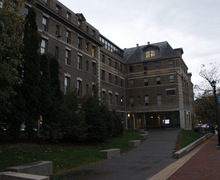‘Destroy All Monsters’ exhibits contributions to early fan culture
Collin Snyder | Contributing Photographer
The "Destroy All Monsters" exhibit focuses on the evolution of fandom over time. The exhibition is on the sixth floor of Bird Library as a part of the Special Collections Research Center.
Get the latest Syracuse news delivered right to your inbox.
Subscribe to our newsletter here.
“Destroy All Monsters” is more than just the name of a 1968 Godzilla movie and a zine-making, anti-rock band from Detroit. Bird Library’s new Special Collections Research Center exhibit of the same name joins the sci-fi and punk scenes to tell a story of fan culture.
“Destroy All Monsters” shines a light on two major 20th-century grassroots efforts to maintain the sci-fi and punk fandoms. The SCRC exhibit on the sixth floor of Bird displays several fan-made magazines, colloquially called zines, early cosplay photography and even fan-made sci-fi movies. The exhibit is on view from now through the rest of the semester.
“While the phrase may bring to mind violence for some, ‘Destroy All Monsters’ seeks to portray not literal, but creative acts of destruction and reimagination,” Danny Sarmiento, curator of the exhibition, wrote in a statement to The Daily Orange.
People may not think of fans as major influences on society, but Sarmiento refuted this in his speech at the exhibition’s opening ceremony on Thursday. He drew a parallel to sports, explaining how fan culture is much more impactful than just subcultural sects.
In sports, home games have a reputation for being particularly difficult for away teams, as fans influence the game with rowdiness and boisterous noise, Sarmiento said. He said fans of other groups have similar significant impacts.
“While by no means a comprehensive history of fandom, the objects displayed here illustrate the legacy of fan participation broadly, and recognize the contributions of the individual fan,” Sarmiento said.
The new exhibition, though a retrospective of popular culture, is well-attended by students, Cristina Hatem, director of marketing for Syracuse University Libraries, said. Even though the exhibitions might not reflect current popular culture, people are still drawn to the genre’s history.

Collin Snyder | Contributing Photographer
The exhibition includes old covers from the early 20th century. These are just part of the reproductions and artifacts that are on exhibition.
“It’s got that pop culture feel and vibe, and there’s a lot of students interested in sci-fi, so hopefully they can find something that they can relate to,” Hatem said. “Retro is always in.”
Max Wagh, administrative coordinator at SCRC, is a sci-fi enthusiast. They used to attend sci-fi conventions, and enjoyed how conventiongoers celebrated socially-deemed “weird” things with passion and excitement.
The punk portion of the exhibition demonstrates the progressive aspects of the movement in the 20th century. On display are magazines that combat the exclusion of gay and lesbian punk music fans, like “Homocore” and “Outpunk,” along with fan photography of San Francisco punk shows.
These fandoms may have changed with the advent of digital media, as physical media is now far less prevalent, but punk music is still alive and well, graduate student Chaithanya Nair said. For Nair, punk and politics are inextricably linked.
“The punk scene was more expressive (than political movements),” Nair said. “If you listen to someone like Lydia Lunch or even someone like The Clash, they had a lot of (political) elements.”
The main issue in the current punk scene is label politics, Nair said. Much of the political aspects of punk music are suppressed by corporations, but there’s still a vibrant underground scene, especially in post-Brexit Great Britain, Nair said. Nair named groups like Black Midi, Turnstile and Black Country, New Road as current punk bands that continue the scene’s initial ethos.
Meghan Murphy, a staff member in the physics department, came to the exhibition because an acquaintance was involved in creating it, but was particularly interested in the physical media on display. Murphy collects hand-painted 45-rpm vinyls that she gets from small house shows, and though not an avid member of any fandom, she still admires the tangibility associated with media artifacts.
Wagh, through their work at SCRC, has developed a similar appreciation for physical media. There’s an enchanting quality to physical media that digital media can’t replicate, which is a core element of the exhibition.
“I love physical material just for the brain chemistry geeking out element when you hold a zine in your hands,” Wagh said. “‘Oh my god, someone made this with their hands’ which is a little bit harder to do.”
The physical pieces on display are a lasting testament of the importance of fan culture, Sarmiento said. These early works allowed fans who were social outcasts to connect with one another, and, in the end, he said, assert their uniqueness.
“These creative acts are not only statements of admiration but representations and assertions of individuality and solidarity with others in common cause,” Sarmiento said.
Published on September 17, 2024 at 11:39 pm






